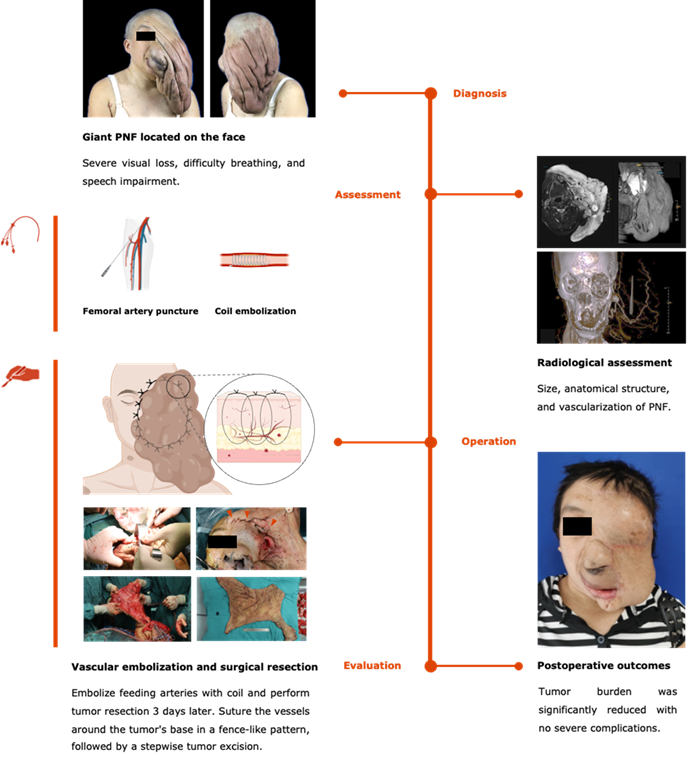New Surgical Technique Safely Removes Giant Nerve Tumors
Published 14 July, 2025
A research team from Shanghai Jiao Tong University School of Medicine has developed an innovative surgical technique — known as FENCY ligation — combined with preoperative embolization to improve the safety and effectiveness of removing giant plexiform neurofibromas (PNF). By reducing the risk of complications and improving recovery time, the team’s findings, published in the Chinese Journal of Plastic and Reconstructive Surgery, shine a new light on how surgical practices can evolve in the treatment of complex tumors like giant PNF.
PNF are benign tumors frequently associated with neurofibromatosis Type 1 (NF1), a genetic disorder with an incidence of approximately 1 in 3,000 live births. PNF occur in approximately 25% of NF1 patients and can grow to massive sizes, leading to severe disfigurement and functional impairments.
“It has been challenging resecting giant PNF, particularly when the tumors are highly vascular and located in critical anatomical regions where bleeding and irreversible nerve damage are likely to occur,” shares Dr. Zhichao Wang, lead researcher of the study. “The FENCY ligation technique, combined with preoperative embolization, provides a dual preoperative and intraoperative intervention that effectively addresses these challenges. By improving hemostasis and enhancing surgical precision, this approach facilitates better overall outcomes and minimizes complications.”
The term “FENCY” reflects that this procedure requires thorough suture ligation of the tumor’s surrounding vasculature in a “fence-like” pattern. Out of 11 patients who underwent the procedure, the results were highly promising. The median tumor size was 30.4 cm, with one tumor reaching as large as 55.6 cm.
“Despite the complexity of the surgeries, most patients reported significant functional improvement and high levels of satisfaction,” says Wang. “It’s gratifying to see how these patients, some of whom had been dealing with these tumors for years, regained mobility and improved their quality of life after surgery.”
FENCY demonstrated its effectiveness even in complex anatomical areas such as the face and neck, which are typically challenging to operate on due to the tumors' proximity to critical structures. “In addition to its clinical benefits, the new technique shows promise for advancing the overall treatment strategies for NF1-associated tumors,” adds Wang.
The research team is optimistic that this method can be widely applied to similar cases, providing a safer, more efficient solution for resecting giant PNF. Nonetheless, they hope that larger patient cohorts will be used to fully understand the long-term impacts and refine the procedure further.

Contact author name: Zhichao Wang, Department of Plastic and Reconstructive Surgery, Shanghai Ninth People's Hospital, Shanghai Jiao Tong University School of Medicine, Shanghai, 200011, China. shmuwzc@163.com
Funder: This work was supported by grants from the National Natural Science Foundation of China (grant nos. 82472579, 82172228, and 82202470), Shanghai Plastic Surgery Research Center of Shanghai Priority Research Center (grant no. 2023ZZ02023), Shanghai Clinical Research Center of Plastic and Reconstructive Surgery supported by the Science and Technology Commission of Shanghai Municipality (grant no. 22MC1940300), Project of Biobank (grant no. YBKA202204) from Shanghai Ninth People’s Hospital of Shanghai Jiao Tong University School of Medicine, and Cross-Disciplinary Research Fund of Shanghai Ninth People’s Hospital of Shanghai Jiao Tong University School of Medicine (grant no. JYJC202407).
Conflict of interest: The authors declare no conflict of interests.
See the article: Zhichao Wang, Xuan Yu, Yihui Gu, Wei Wang, Chengjiang Wei, Bin Gu, Jun Yang, Qingfeng Li. An innovative resection of giant neurofibromas. Chin J Plast Reconstr Surg. 2025(7)2:71–77. doi:10.1016/j.cjprs.2025.06.003.